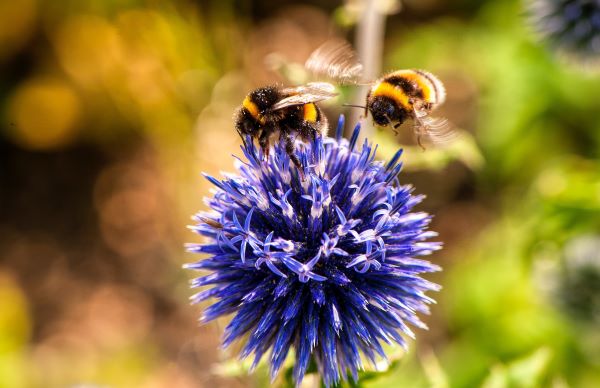Are you keen to help pollinators? Whether you have a window box or a large garden, there are some simple things you can do to help.
It’s Bees’ Needs Week 8 – 18 July 2019 and the organiser, The Bumblebee Conservation Trust, has 5 tips to benefit bumblebees:
- Grow more flowers, shrubs & trees
We need more pollen- and nectar-rich plants in our gardens, balconies, allotments and in the landscape around our homes. These provide food for bees and other pollinators throughout the year.
How you can help: plant some species that bees love: Pussy willow, Primroses and Crocuses in spring, Lavenders, Meadow cranesbill and Ox-eye daisies in summer, Ivy and Hebes in autumn, and Mahonia shrubs and Cyclamen in winter.
- Let it grow wild
Wild areas provide food sources and/or breeding places for pollinators and you can take simple actions to manage your outdoor spaces.
How you can help: leave patches to grow wild. Plants such as stinging nettles and dandelions provide other food sources (such as leaves for caterpillars) and breeding places for butterflies and moths.
- Cut grass less often
Native flowering plants in grass areas, field corners, verges and specially sown flower-rich habitats support the greatest diversity of insect pollinators by providing nectar and pollen resources, places to nest or breed and leaves for caterpillars.
How you can help: cut your grass less often. Removing the cuttings allows plants to flower.
- Don’t disturb insect nests and hibernation spots
As well as ensuring there is food throughout the year for insect pollinators, it is also important to make sure they can nest in safety so that they and the next generation can survive over the winter, to start again in the following spring.
How you can help: avoid disturbing grass margins, bare soil, hedgerows, trees, dead wood or walls, as this is where nesting or hibernating insects like to be.
- Think carefully about whether to use pesticides
Pesticides are detrimental where pollinators are active or nesting, or where their food plants are flowering.
How you can help: avoid chemicals and try adopting organic gardening methods, such as picking pests off your plants and by using barriers and traps instead of chemicals.
Gardening to Attract Bumblebees
Food
Bumblebees are dependent on the nectar and pollen of flowers, but they also shelter. To supply a continuous food source for the bees, plant a variety of species that will bloom from spring to autumn. Most bumblebees prefer perennial flowers, so herbs and traditional cottage garden plants are great.
How you can help: plant pollen- and nectar-rich plants in large clumps or drifts, so that the bees don’t need to travel too far to forage for their favourite flowers. Blooms of different shapes are also essential, as each species has a different length tongue.
Flowers that attract bumblebees
- Oregano, Lavender, Rosemary, Catmint and Deadnettle
- Foxgloves and Hebe
- Teasels and Scabiouses
- Vetches, Clovers, Broom, Trefoils and Runner Beans
- Single-flowered Roses, Brambles and Raspberries
- Heathers, Blueberries, Bilberries and Strawberry Tree
Nesting
Bees need suitable places to nests, which may be below ground (mining bees and many bumblebees), in dense vegetation on the surface (carder bumblebees), or in holes in logs, plant stems and walls (mason and leafcutter bees).
How you can help: provide artificial bee nests or make your own! Studies show that the most successful designs were nests made of bamboo cane sections or wooden blocks drilled with holes. Also, try not to be too tidy – leave a part of your garden a little wild to offer suitable nesting sites. These might include long grass, compost heaps, woodpiles and hedgerows.
Why are Pollinators Important?
Insect pollinators – including honey bees, bumblebees, solitary bees, wasps, hoverflies and other flies, butterflies, moths and beetles – are essential for seed production by wild plants as well as flowers, vegetables and fruit grown in gardens. They support healthy ecosystems by helping plants to produce the fruits and seeds that birds and other animals rely on.
Gardens are essential habitats for bees. By growing a range of the right sorts of flowers throughout the year, leaving some areas of tall vegetation and providing nesting sites, you can increase the value of your garden for bees and other pollinators, benefit wildflowers and your garden plants, plus ensure that your fruit and vegetable crops are productive.
Follow Bees’ Needs Week on social media from 8 – 18 July 2019 using the hashtag #beesneeds.
.
Last Updated on December 22, 2023 by Suttons Horticultural Team





